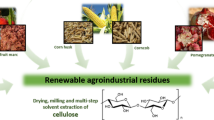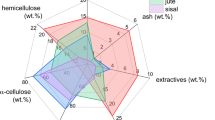Abstract
This work evaluated residues of garlic crops from Colombia, as promising sources of cellulosic materials. We demonstrated an efficient re-engineering of the waste products to highly valuable cellulose materials as precursors of cellulosic derivatives suitable for functionalization. To study the feasibility of extracting cellulose from garlic raw fibers, the steam explosion technique was used along with mild chemical treatment. These processes included usual chemical procedures such as alkaline extraction, bleaching, and acid hydrolysis but with a mild concentration of the chemicals. The chemical constituents of the fiber in each processing step were determined by standard procedures. The extracted cellulose microfibers were characterized by Fourier Transform Infrared spectroscopy (FTIR), Thermogravimetric Analysis (TGA), Powder X-ray Diffractometry (XRD), and Scanning Electron Microscope (SEM). The FTIR spectra, as well as XRD, TGA and SEM results, showed changes in the peaks corresponding to hemicelluloses and lignin, which were removed from the fiber surface because of the treatments. These promising results proved revalorization of garlic by-product to produce cellulose derivatives and its potential use as reinforcement in the preparation of useful composites.
Graphic Abstract







Similar content being viewed by others
References
Mohammadi-Khoo, S., Moghadam P.N., Fareghi A.R., Movagharnezhad N.: Synthesis of a cellulose-based hydrogel network: characterization and study of urea fertilizer slow release. J. Appl. Polym. Sci. (2016). https://doi.org/10.1002/app.42935
Bondeson, D., Mathew, A., Oksman, K.: Optimization of the isolation of nanocrystals from microcrystalline cellulose by acid hydrolysis. Cellulose 13, 171–180 (2006)
Pinzón, R.H.: Los cultivos de cebolla y ajo en Colombia: Estado del arte y perspectivas. Rev. Colomb. Cienc. Hortícolas 3(1), 45–55 (2006)
FAOSTAT: Garlic crops. https://www.fao.org/faostat/en/#data/QC (2016)
Jayaramudu, J., Reddy, G., Varaprasad, K., Sadiku, E.R., SinhaRay, S., Varada Rajulu, A.: Preparation and properties of biodegradable films from Sterculia urens short fiber/cellulose green composites. Carbohydr. Polym. 93, 622–627 (2013)
Reddy, J.P., Rhim, J.W.: Extraction and characterization of cellulose microfibers from agricultural wastes of onion and garlic. J. Nat. Fibers 15, 465–473 (2018)
Rhim, J.W., Reddy, J.P., Luo, X.: Isolation of cellulose nanocrystals from onion skin and their utilization for the preparation of agar-based bio-nanocomposites films. Cellulose 22(1), 407–420 (2015)
Papu, S., Singh, A., Jaivir, S., Sweta, S., Arya, A.M., Singh, B.R.: Effect of drying characteristics of garlic: a review. J. Food Process. Technol. 5(4), 318–324 (2014)
Buritica, C.P.: Plant diseases and distribution of crops in the tropics. ASCOLFI-Informa 20(2), 17–23 (1994)
Fritsch, R.M., Friesen, N.: Evolution, domestication and taxonomy. In: Allium Crop Science: Recent Advances. (2002). https://doi.org/10.1079/9780851995106.0005. ISBN: 9780851995106.
The Editors of Encyclopædia Britannica. Onion. Encyclopaedia Britannica. https://www.britannica.com/plant/onion-plant (2016)
Bhatnagar, A., Sain, M.: Processing of cellulose nanofiber-reinforced composites. J. Reinf. Plast. Compos. 24, 1259–1268 (2005)
Kian, L.K., Jawaid, M., Ariffin, H., Alothman, O.Y.: Isolation and characterization of microcrystalline cellulose from roselle fibers. Int. J. Biol. Macromol. 103, 931–940 (2017)
Lorenzo-Hernando, A., Martín-Juárez, J., Bolado-Rodríguez, S.: Study of steam explosion pretreatment and preservation methods of commercial cellulose. Carbohydr. Polym. 191, 234–241. (2018). https://doi.org/10.1016/j.carbpol.2018.03.021
Kallel, F., Bettaieb, F., Khiari, R., García, A., Bras, J., Chaabouni, E.: Isolation and structural characterization of cellulose nanocrystals extracted from garlic straw residues. Ind Crops Prod. 87, 287–296 (2016)
French, A.D., Santiago Cintrón, M.: Cellulose polymorphy, crystallite size, and the Segal Crystallinity Index. Cellulose 20, 583–588 (2013)
Fareez, I.M., Ibrahim, N.A., Wan Yaacob, W.M.H., Mamat Razali, N.A., Jasni, A.H., Abdul Aziz, F.: Characteristics of cellulose extracted from Josapine pineapple leaf fibre after alkali treatment followed by extensive bleaching. Cellulose (2018). https://doi.org/10.1007/s10570-018-1878-0
Deepa, B., Abraham, E., Cordeiro, N., Mozetic, M., Mathew, A.P., Oksman, K.: Utilization of various lignocellulosic biomass for the production of nanocellulose: a comparative study. Cellulose 22(2), 1075–1090 (2015)
Abraham, E., Deepa, B., Pothan, L.A., Jacob, M., Thomas, S., Cvelbar, U.: Extraction of nanocellulose fibrils from lignocellulosic fibres: A novel approach. Carbohydr. Polym. 86(4), 1468–1475 (2011)
Johar, N., Ahmad, I., Dufresne, A.: Extraction, preparation and characterization of cellulose fibres and nanocrystals from rice husk. Ind. Crops Prod. 37(1), 93–99 (2013)
Elanthikkal, S., Gopalakrishnapanicker, U., Varghese, S., Guthrie, J.T.: Cellulose microfibres produced from banana plant wastes: isolation and characterization. Carbohydr. Polym. 80, 852–859 (2010)
Reddy, N., Yang, Y.: Structure and properties of high quality natural cellulose fibers from cornstalks. Polymer 46, 5494–5500 (2005)
Łojewska, J., Miśkowiec, P., Łojewski, T., Proniewicz, L.M.: Cellulose oxidative and hydrolytic degradation: in situ FTIR approach. Polym Degrad Stab. 88, 512–520 (2005)
Nuruddin, M., Chowdhury, A., Haque, S.A., Rahman, M., Farhad, S.F., Jahan, M.S.: Extraction and characterization of cellulose microfibrils from agricultural wastes in an integrated biorefinery initiative. Cellul. Chem. Technol. 45(5–6), 347–354 (2011)
Ibrahim, M.M., Agblevor, F.A., El-Zawawy, W.K.: Isolation and characterization of cellulose and lignin from steam-exploded lignocellulosic biomass. BioResources 5(1), 397–418 (2010)
Kalita, R.D., Nath, Y., Ochubiojo, M.E., Buragohain, A.K.: Extraction and characterization of microcrystalline cellulose from fodder grass; Setaria glauca (L) P. Beauv, and its potential as a drug delivery vehicle for isoniazid, a first line antituberculosis drug. Colloids Surf. B 108, 85–89 (2013)
Trache, D., Hussin, M.H., HuiChuin, C.T., Sabar, S., Fazita, M.R.N., Taiwo, O.F.A.: Microcrystalline cellulose: isolation, characterization and bio-composites application: a review. Int. J. Biol. Macromol. 93, 789–804 (2016)
Alemdar, A., Sain, M.: Isolation and characterization of nanofibers from agricultural residues Wheat straw and soy hulls. Bioresour. Technol. 99(6), 1664–1671 (2008)
Zhao, J., Wei, Z., Feng, X., Miao, M., Sun, L., Cao, S., Shi, L., Fang, J.: Luminescent and transparent Nanopaper based on rare-earth up-converting nanoparticle grafted nanofibrillated cellulose derived from garlic skin. ACS Appl. Mater. Interfaces 6, 14945–14951 (2014)
Trache, D., Donnot, A., Khimeche, K., Benelmir, R., Brosse, N.: Physico-chemical properties and thermal stability of microcrystalline cellulose isolated from Alfa fibres. Carbohydr. Polym. 104, 223–230 (2014)
Sjöström, E.: Wood Chemistry: Fundamentals and Applications [Internet]. Wood Chemistry, pp 165–203. https://www.sciencedirect.com/science/article/pii/B9780080925899500127%5Cn https://books.google.com/books?id=Sv3xcS6eS5QC&pgis=1 (2014)
Azubuike, C.P., Okhamafe, A.O.: Physicochemical, spectroscopic and thermal properties of microcrystalline cellulose derived from corn cobs. Int. J. Recycl. Org. Waste Agric. 1, 1–9 (2012)
Lee, C.M., Kafle, K., Belias, D.W., Park, Y.B., Glick, R.E., Haigler, C.H.: Comprehensive analysis of cellulose content, crystallinity, and lateral packing in Gossypium hirsutum and Gossypium barbadense cotton fibers using sum frequency generation, infrared and Raman spectroscopy, and X-ray diffraction. Cellulose 22(2), 971–989 (2015)
Hussin, M.H., Pohan, N.A., Garba, Z.N., Kassim, M.J., Rahim, A.A., Brosse, N.: Physicochemical of microcrystalline cellulose from oil palm fronds as potential methylene blue adsorbents. Int. J. Biol. Macromol. 92, 11–19 (2016)
Lu, P., Hsieh, L.Y.: Preparation and properties of cellulose nanocrystals: rods, spheres, and network. Carbohydr. Polym. 82(2), 229–236 (2010)
Chen, W., Yu, H., Liu, Y., Chen, P., Zhang, M., Hai, Y.: Individualization of cellulose nanofibers from wood using high-intensity ultrasonication combined with chemical pretreatments. Carbohydr. Polym. 82(2), 329–336 (2011)
Bettaieb, F., Khiari, R., Dufresne, A., Mhenni, M.F., Belgacem, M.N.: Mechanical and thermal properties of Posidonia oceanica cellulose nanocrystal reinforced polymer. Carbohydr. Polym. 123, 99–104 (2015)
Segal, L., Creely, J.J., Martin, J., Conrad, C.M.: An empirical method for estimating the degree of crystallinity of native cellulose using the x-ray diffractometer. Text. Res. J. 29(10), 786–794 (1959)
Zhang, Y.H., Lynd, L.R.: Toward an aggregated understanding of enzymatic hydrolysis of cellulose: noncomplexed cellulase systems. Biotechnol. Bioeng. 88(7), 797–824 (2004)
Fengel, D., Wegener, G.: Wood chemistry, ultrastructure, reactions. Wood Chem. Ultrastruct React. 23(11), 601–602 (1989)
Mwaikambo, L.Y., Ansell, M.P.: Mechanical properties of alkali treated plant fibres and their potential as reinforcement materials. I. hemp fibres. J. Mater. Sci. 41, 2483–2496 (2006)
Yue, Y., Han, G., Wu, Q.: Transitional properties of cotton fibers from cellulose I to cellulose II structure. BioResources 8, 6460–6471 (2013)
Malladi, R., Malladi, N., Robert, M., Elkoun, S.: Importance of agricultural and industrial waste in the field of nano cellulose and its recent industrial developments: a review. ACS Sustain. Chem. Eng. 5:2. doi: 10.1021/acssuschemeng.7b03437 (2018)
Balakrishnan, P., Geethamma, V.G., Gopi, S., Thomas, M.G., Kunaver, M., Huskic, M., Kalarikkal, N., Volova, T., Rouxel, D., Thomas, S.: Thermal, biodegradation and theoretical perspectives on nanoscale confinement in starch/cellulose nanocomposite modified via green crosslinker. Int. J. Biol. Macromol. 134, 781–790 (2019)
Gassan, J., Bledzki, A.K.: Thermal degradation of flax and jute fibers. J Appl Polym Sci. 82(6), 1417–1422 (2001)
Shankar, S., Rim, J.-W.: Preparation of nanocellulose from micro-crystalline cellulose: The effect on the performance and properties of agar-based composite films. Carbohydr. Polym. 135, 18–26 (2016)
Morán, J.I., Alvarez, V.A., Cyras, V.P., Vázquez, A.: Extraction of cellulose and preparation of nanocellulose from sisal fibers. Cellulose 15(1), 149–159 (2008)
Ren, H., Zhang, R., Wang, Q., Pan, H., Wang, Y.: Garlic root biomass as novel biosorbents for malachite green removal: parameter optimization, process kinetics and toxicity test. Chem. Res. Chin. Univ. 32, 647–654 (2016)
John, M.J., Anandjiwala, R.D.: Recent developments in chemical modification and characterization of natural fiber-reinforced composites. Polym. Compos. 29, 187–207 (2008)
Acknowledgements
The authors acknowledge GRUPO DE INVESTIGACION EN QUIMICA Y TECNOLOGIA DE ALIMENTOS, UPTC, Colombia, for helping with most of the analysis and beneficial discussions.
Author information
Authors and Affiliations
Corresponding author
Ethics declarations
Conflict of interest
The authors declare that they have no conflict of interest.
Informed Consent
Informed consent was obtained from all individual participants included in the study.
Additional information
Publisher's Note
Springer Nature remains neutral with regard to jurisdictional claims in published maps and institutional affiliations.
Rights and permissions
About this article
Cite this article
Moreno, L.M., Gorinstein, S., Medina, O.J. et al. Valorization of Garlic Crops Residues as Precursors of Cellulosic Materials. Waste Biomass Valor 11, 4767–4779 (2020). https://doi.org/10.1007/s12649-019-00799-3
Received:
Accepted:
Published:
Issue Date:
DOI: https://doi.org/10.1007/s12649-019-00799-3




